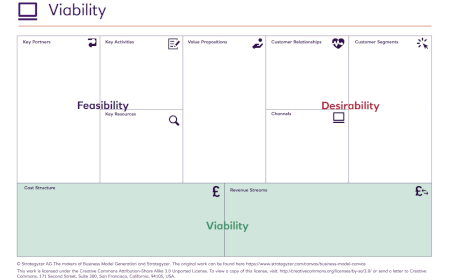We’ll help you get to grips with:
- What numbers you should know
- Why they’re important
- How to understand them and what they tell you
Completed your Business Model Canvas yet?
It’ll show you the feasibility, desirability and viability of elements of your business. If you haven’t done one already, now’s a great time to get it all down. It will highlight different strengths and weaknesses now, and in the future. And as your business constantly evolves, so will your business model.
Check your financial knowledge
To get started, read through and note down answers to the following questions about your business finances. They’ll help you identify what you already know and what elements you need to understand further.
Don’t worry if you don’t have all the answers now, we’ve got lots of support available that will help you.
What do you know already?
-
01
How much do you charge for your products or services?
How do you get to that magic number – low value and high volume or vice versa. And what do you need to charge if what you’re charging now isn’t enough?
-
02
What does it cost you to take your products or services to market?
And do you make enough sales?
-
03
What does it cost you to run the business and pay your weekly/monthly commitments?
That includes everything from wages and supplier costs to rent and your mobile phone.
-
04
What are your net profit margins?
You need to know about your profit margins because a percentage up or down can make a significant difference to your finances.
-
05
What’s your breakeven point?
That’s when your business will be profitable, if it isn’t already.
-
06
How much profit is your business forecast to generate this year?
You’ll need to plan and forecast your sales for the future, including how much stock you might need next year.
-
07
When and how do you plan to expand your team/products/services/operations?
This will involve your reserves, resources and how much money you have to allow for growth.
-
08
How much can you afford to pay yourself as a wage?
Think about right now and into the future, and don’t forget you’ll have personal bills to pay too.
Further reading
We’ve also got other articles on funding to help you get on top of your finances.
A-D
Assets are any items of value within a business, including product inventory, IT equipment, and any intellectual property (IP) the company owns.
Capital is money a business has in its accounts, assets and investments. This can be negative, known as debt or positive, known as equity.
Cash flow is one of the most important elements to be aware of. In the early stages it keeps your business functioning. It’s the overall movement of funds through your business each month, including income and expenses.
Cost of goods sold are costs associated with getting the product or service to market; e.g. raw materials, manufacturing expenses, labour costs. These costs can also be referred to as cost of sales or direct costs.
Depreciation is when a business's assets decrease in value due to the time that has passed since it was purchased.
E-R
Expenses or costs are costs a business incurs each month in order to operate, including rent, utilities, legal costs, employee salaries, contractor pay, and marketing and advertising.
Gross profit is the sum of total revenue minus the cost of goods sold showing you the profit before business expenses are deducted.
Liabilities includes any debt accrued by a business since it started trading including bank loans, credit card debts and money owed to vendors and product manufacturers.
Net profit is the profit that remains after business expenses are deducted from the gross profit. Often referred to as the bottom line.
Revenue is money that comes into the business. Also known as sales, income, or turnover.
What’s next?
You could also:
- Read our article on financial management
- For more insights on allsorts of business areas, visit the NatWest Business Insights hub
- Discover our communities and networks by connecting with peers and experts
This material is published by NatWest Group plc (“NatWest Group”), for information purposes only and should not be regarded as providing any specific advice. Recipients should make their own independent evaluation of this information and no action should be taken, solely relying on it. This material should not be reproduced or disclosed without our consent. It is not intended for distribution in any jurisdiction in which this would be prohibited. Whilst this information is believed to be reliable, it has not been independently verified by NatWest Group and NatWest Group makes no representation or warranty (express or implied) of any kind, as regards the accuracy or completeness of this information, nor does it accept any responsibility or liability for any loss or damage arising in any way from any use made of or reliance placed on, this information. Unless otherwise stated, any views, forecasts, or estimates are solely those of the NatWest Group Economics Department, as of this date and are subject to change without notice.


